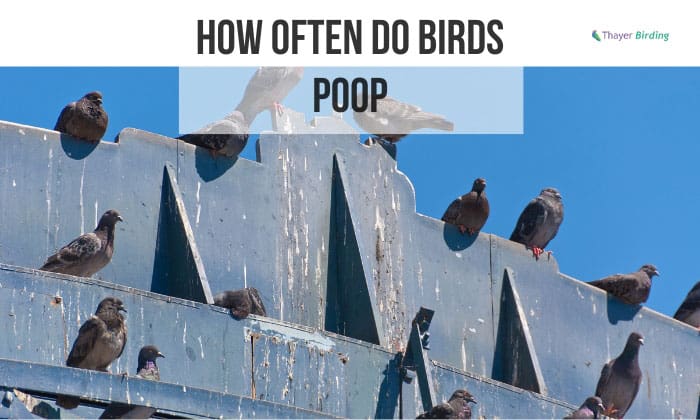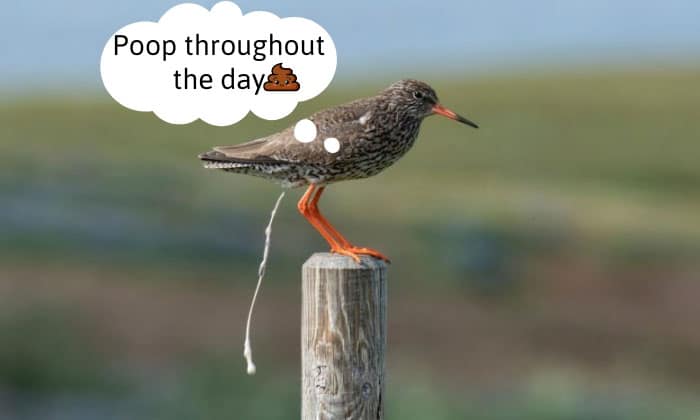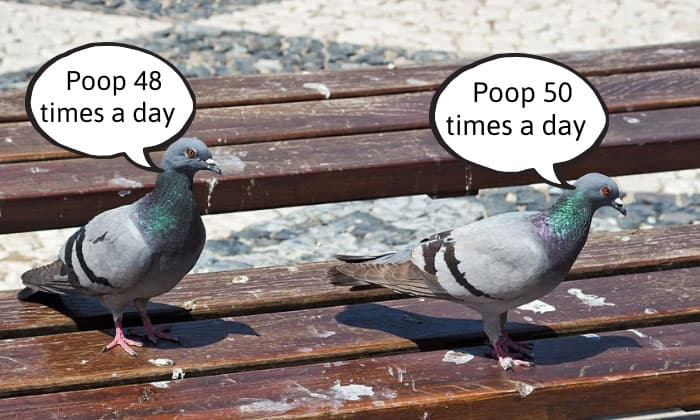The answer to how often do birds poop is plenty of times a day! The frequency can vary depending on several factors such as the time of day, bird size, species, the food they eat, and their overall health. But if we are to give an estimate, it’s between every 15 minutes to every hour.
Shall we dig deeper into everything there is to know about the number of times a bird poops? Let’s not wait and get into it!
Table of Contents
How Often Do Birds Poop
There is no definite answer to this question. The frequentness differs from one bird to another, just like how hummingbirds poop every 20 minutes and pigeons poop every 15 minutes. What are the factors that affect this number?
Aside from the obvious reasons like how much they eat and what food they are ingesting, the species and size of the bird also influence how often they defecate. Do you want to find out how often cockatoos poop? Check this table below:
| Bird Size | Species | Pooping Frequency |
| Small | Lovebirds, Sparrows, Budgerigar, Canaries | Every 15 minutes |
| Medium | Pigeons, Cockatoos, Lorikeets, Robins | Every 30 minutes |
| Large | Owls, Crows, Chickens, Macaws, Cranes | Every 60 minutes |
This chart somewhat explains that the smaller the birds are, the more frequently they have to expel their poop. This has something to do with the size of their digestive system, among other factors.
It takes longer for large birds to digest the food they consume since it has a long way to go before it gets digested and released.
Birds poop so much more than other creatures to the point that many refer to them as poop machines. This is because they spend most of their days foraging and eating, not only for themselves but for their young ones. It also has something to do with how a bird’s body is built to match the high levels of energy they need to live and survive in different environments.
Having a parrot poop chart is handy for any bird owner no matter what bird species you have. Monitoring how often your pet is pooping is crucial alongside checking the dropping properties such as:
- Color
- Smell
- Texture
- Liquid Component
- Size, and
- Amount
Taking notes on these can help you determine the overall health of your bird. It’ll let you know if they are in the normal range or need special care and attention.
Why do they poop so much?
Birds poop so much that their droppings are everywhere on the benches, cars, pavements, and sometimes on us. The frequency varies depending on the avian species, but even the largest birds poop a lot!
The explanation behind this lies in their digestive tracts which are designed especially for survival.

- A bird’s digestive system starts from the mouth, then the esophagus, stomach, and finally the intestine.
- The process is uniquely streamlined, which results in fast nutrient absorption and quick digestion.
- Other contributing factors to the rapid digestion in birds are the high metabolic rate and the absence of a urinary system.
When do birds poop?
Birds poop throughout the day, with a higher frequency in the morning. This is because they defecate less or never at all during the night when they are asleep.
Fair warning: Never scare a group of birds. There is a high chance you’ll startle them to the point of pooping. And yes, in unison.
Do birds poop while flying?
They can, they don’t choose a time and place for it! Birds can’t seem to find the right timing to release their poop or they just don’t care at all. It is not uncommon for a bird to poop midair, as experienced by many unfortunate people where it landed.
Moreover, birds poop when they take off. The reason is to lighten their load by releasing waste materials from their bodies. This will save them energy.
How many times do birds poop a day?
On average, a bird will poop 48 to 50 times a day. Smaller birds poop more than this number, while larger ones can only poop around 24 times every day. Lovebirds are known to poop approximately 100 times a day because of their fast metabolism.
Frequently Asked Questions
How long can a bird go without pooping?
Larger birds can have a one-hour interval before they have to poop again, while smaller avians need shorter time between pooping sessions.
Do birds pee and poop at the same time?
Birds don’t actually pee in the technical sense. What they release is a solid uric acid found in their poop. This means they pee at the same time that poop is released from one exit called the “cloaca”.
What does bird poop look like?
Bird poop is unique-looking with its green hue and toothpaste-like consistency. The color and texture can also vary depending on the bird’s diet.
Despite the white traces you see left behind by dried bird poop, it is not actually the real color of their droppings. The white part is the urine made of uric acid, while the darker part is the actual bird waste or poop.
How often do baby birds poop?
Nestlings poop after each feeding. You can say that their pooping schedule is in sync with their feeding time. Scientists suggest that feeding activates the stimulus that starts defecation.
To keep the nest clean and free of harmful parasites, parent birds dispose of the poop immediately. They do this by swallowing the fecal sacks or transporting them far from the nest. Sometimes, the birds will inch close to the edge of the nest before pooping.
Conclusion
Birds’ pooping habits are a fascinating aspect of their biology. From the varied pooping frequency among species to the reasons behind their high output, there’s much to learn about these feathered creatures.
After learning about how often do birds poop, we hope you are now equipped with more knowledge about this topic than before you read this post. By monitoring their droppings, bird owners can gain insights into their pets’ health.
If you have more questions about bird poop that we failed to cover or if you have some interesting things to share, comment on them! We always love hearing from our readers.

George and I became friends after a birdwatching trip with our new group. And we have been enjoying every adventure together. When he told me the idea of establishing a site that shares our experiences and fun, I immediately agreed. After trials and errors, here we have Thayerbirding.



















